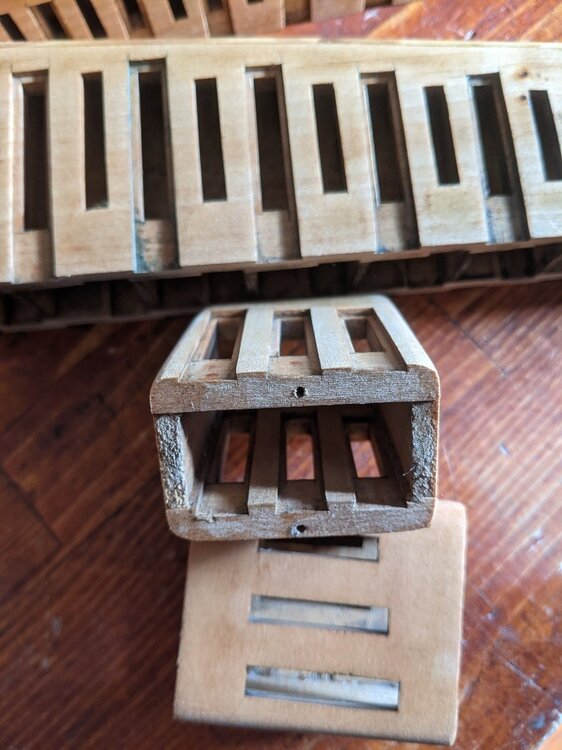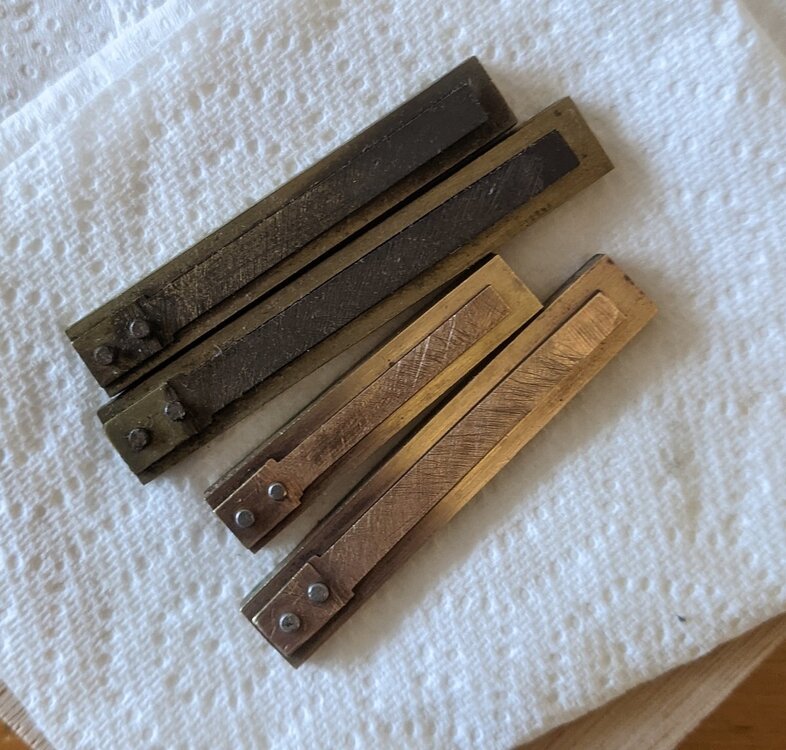
mChavez
Members-
Posts
72 -
Joined
-
Last visited
Recent Profile Visitors
The recent visitors block is disabled and is not being shown to other users.
mChavez's Achievements

Advanced Member (3/6)
-
Where would you glue it to? Bottom of the shoes? Slot sides? I was thinking along the same lines to use olovisc - the stuff is tougher, but does not compress as well as suede.
-
Thank you - paper is what was used in this box too, but surely there's got to be something much better in 2024?
-
MIDI concertina feature wishlist
mChavez replied to Łukasz Martynowicz's topic in Instrument Construction & Repair
What do you use on the other end of the USB cable? Haven't tried the classic MIDI port, but played about with MIDI over USB. -
No suggestions about making single reed shoes airtight in their slots? Come on, I thought that's what you concertina restorers do all day long I am leaning towards some sort of filler/putty...It may "ruin" the woodwork (epoxy most certainly will not be reversible. Wood filler - not so sure about that one), but if the whole block is leaking, one may argue that it's already ruined... I really don't fancy making new ones from scratch at this point. So, put a thin bead of wood filler into the slots, wax the brass shoe and slide it in, let it dry, then slide it out - something along these lines?
-
MIDI concertina feature wishlist
mChavez replied to Łukasz Martynowicz's topic in Instrument Construction & Repair
Teensy 4.1 is a powerhouse, but you will almost certainly need to re-write some code to use native Teensy midi functions. What processor do you plug the controller in? What I found is that although MIDI is supposed to be a "standard", every processor seems to interpret various CC commands differently 🤪. -
Thinking out loud, I don't really care if the reed shoes are flat on their beds, as long as: - there's a perfectly tight contact between the sides of the shoes and the sides of the slots; - There's no gap between the bottom of the reed shoe and the lid gasket. But the reed shoes don't always seem to be perfectly matched to the length of the slots. Any ideas on how to make this as airtight as possible are very welcome.
-
Reed cleaning went reasonably well until the last batch, where one soaking was not enough and I had to take the reeds out, give them a scrub mechanically and then stick them back into the vinegar and then clean again. Also, using steel wool might not have been a very good idea, as a few steel strands got wedged between the reeds and the shoes. Might be a pain to pick them out of the slots. A related question. Apologies for a non-concertina stuff, but the construction of this box is probably closer to a 'tina than a melodeon. I've started cleaning up the reed blocks, but after 150 odd years, the reed beds are not perfectly flat. The more uneven the beds, to more air will leak out, right? Any tips on making flattening these a bit easier than picking out high spots with a chisel? Thank you. On the treble-side reed block, running a dremel on a flat plunge-base might be an option?
-
Phosphor bronze, most likely, as I've got plenty of it. But it's the hole placement rather than the hole making that's hard. If you've fitted the tongue and then mis-align the hole, you're making a new tongue. slight mis-alignment can be fixed while riveting (that's the beauty of it) but not significant mis-alignment. With the punch method the hole is going to be exactly where it needs to be.
-
Thank you. Good idea about the modified nail punch for the head punch. I use a slightly modified (to fit my tooling) method that was explained & demonstrated to me by a Russian harmonika maker, which comes down to: 1) Make the slot in the plate if making a new plate. 2) Cut a strip of spring steel (or any other valid material) and fit the tongue to the slot as tightly as possible. 3) Use a deep throat punch to make the precisely placed rivet hole in the tongue's base. Usually the reedmakers build their own punches, as it needs to have enough space in the jaws for you to be able to place the tongue into the slot, and then, while holding them together, place the plate's rivet end into the punch & make the hole. This makes things a lot easier compared to making a hole first and then having to fit the tongue to the slot and the hole at the same time. 4) Profile the tongue, then rivet in any way you like (domed or flat). Rather than trying to make my own with little relevant tools & skill, I bought a hand punch. Not the perfect solution, as the punching action is upside-down compared to what the Russians use (in their case the male part of the die is fixed and the female is moving, making life a lot easier), but it works. Something like this works for thin plates (3mm max I think), but the smallest die is 3/32". https://cjautosheywood.co.uk/product/metal-hole-punch-mw42/ This one will work for thicker plates but the smallest die is 1/82": https://www.wnealservices.com/product/metal-hole-punch/ If I need to do 2 small rivets, I can drill out the bottom, fit, punch, single- rivet the tongue, then just use a pillar drill to drill the second hole & rivet that one too.
-
By the way, don't use this mix on steel reeds, they just seem to come out black... But the steel rivets seem to be fine. Here's a problem: I'm missing a couple reeds; there's about half a dozen broken ones and a few reeds that were broken in the past and replaced with steel tongues. I don't think having steel alongside brass is a problem, but the replacement ones are so poorly fitted, that I might as well take them out and do a much better job riveting new ones myself, without 0.5mm gap between reed and shoe 🤢. Half a dozen new reeds to be made. The rivets are 1.5mm in diameter, and I can only work with 2.5mm or 3mm (don't have a punch that would work with anything smaller). I'm thinking of drilling the bottom rivet out to 2.5mm, but there's not enough room in the shoe to enlarge the top rivet, so I'll have to use 1.5mm-1.6mm. Does anyone know a good source for 1.5mm or 1.6mm rivets? Also, can brass or copper rivets be used for this job? (I've only used steel so far).
-
Not horolene levels of shine, but vinegar has done a decent enough job, with just a slight rub with very fine steel wool for a good measure after the bath. - 1/2 White vinegar diluted 1:1 or 1:2 with water. - Teaspoon or two of baking soda - Teaspoon of salt - Some flak from the Mrs for using her kitchen. Light tarnish gone within 2 hrs. Heavier stuff needs an overnight soak I think.
-
Planning a first build- reed question
mChavez replied to Rayune's topic in Instrument Construction & Repair
Forgive me for my ignorance, but how many reeds are we talking about for a 30-button Anglo? While Dix never bothered replying to my questions on several occasions (geez, if you don't want to reply to emails, just put up a price list for you products, like the rest of the vendors in the world), the quotes that I was getting for Italian sets of ~3x35 reed pairs (so, ~200 "individual" reeds) from other suppliers would typically run into 500 EUR for tipo and closer to 900 for a mano. The attached file suggests ~100 EUR for various a mano grades. @Theo - in your experience, how far can one safely push a reed? I imagine going heavier is the right direction, as going lighter requires taking off some meat off the tip, and the tips tend to be quite thin on higher end reeds. -
Planning a first build- reed question
mChavez replied to Rayune's topic in Instrument Construction & Repair
In my mind I compare reed sound to wiping my behind with sandpaper. The best of the best hand made reeds that I've heard are about 2000 wet. Cheap reeds on entry level instruments can be as bad as 80 grit dry, and a set of brand new reeds for 20 eur (if such sets exist...I think you've lost a zero there somewhere) will be an equivalent of gluing broken glass to a canvas rag... If you are thinking of saving money by building your own - don't. It won't work out. -
Planning a first build- reed question
mChavez replied to Rayune's topic in Instrument Construction & Repair
Hi, I've dipped my toe into squeezebox making, but it's quite low down on my priority list at the moment, so can't boast that I've finished a box yet. It sounds like you are only discovering the squeezebox world, so have a good go at playing any type you can find. I've started on a CBA, then discovered a unisonoric bandoneon, then fell in love with a diatonic accordion/melodeon. As I found out for myself, bando and large diatonics are a lot closer to what I want the squeezebox to do, while I can't say that I care that much for the CBA now. (of course, when I was starting out, I just had a general idea of playing "an accordion".) So do give all of them a try before you commit to a very long & expensive build. Some thoughts: - Making a bandoneon might be easier because you get a lot of space to work inside the box. Everything's bigger. You are not chasing a small & lightweight target. Bellows are easier to source. Bellows technique will most likely be a lot closer to accordion than to a 'tina. Bando doesn't have to be bisonoric - unisonoric ones also exist. You can just build a single voice one, which will put it into concertina territory sound wise, but will still have lots of the bandoneon timbre charm. - You can make your own reeds...Nothing difficult about it, but it is very time consuming - probably not good for your first project. Custom reeds can be ordered, but that's expensive. - There's a huge amount of unforeseen issues that you run into while building, so don't expect a fast result. Most issues seem to arise from the lack of space, hence, see thought number 1. - Being able to do some modelling for laser cutting & (potentially) 3d printing is very handy. - There's very little information about squeezeboxes, so you're on your own. Imho, it makes a lot of sense to make something that's not widely available. Otherwise you are better off buying old & fixing. E.g. making a Hayden 'tina, Kusserow/Wiki bandoneon, or some wild diatonic build (I want to try a Darwin bass end with bayan-sized reeds 🥺, and perhaps a single cassotto MM in the right) makes sense, as you can't buy them. Making a standard-sized stradella CBA does not, as there's tons of old ones available at semi-reasonable prices. Whatever you design needs to be quite simple. Do not go for a 5-voice double cassotto treble with a converter bass. You'll never finish it. -
Wow! That's quite an advert for Horolene. 4 hours in vinegar+baking soda solution, and some of the lighter tarnished reeds are looking quite good. Heavier tarnished ones are looking much better, but still some way to go. I do like the fact that vinegar is not toxic and doesn't smell too bad. Will see what happens if I leave the reeds in there overnight.



